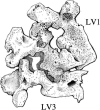Genotypic analysis of the earliest known prehistoric case of tuberculosis in Britain - PubMed (original) (raw)
Genotypic analysis of the earliest known prehistoric case of tuberculosis in Britain
G Michael Taylor et al. J Clin Microbiol. 2005 May.
Abstract
The earliest known case of human tuberculosis in Britain dates to the middle period of the Iron Age, approximately 2,200 years before present. Bone lesions on the spine of a male skeleton excavated at Tarrant Hinton in Dorset, United Kingdom, show evidence of Pott's disease and are supported by molecular evidence of Mycobacterium tuberculosis complex DNA amplified by IS6110 PCR (19). In the present study, we used a further series of sensitive PCR methods to confirm the diagnosis of tuberculosis and to determine the genotype of the infecting strain. These tests demonstrated that this individual was infected with a strain of M. tuberculosis rather than Mycobacterium bovis. The strain had undergone the tuberculosis D1 deletion affecting the mmpS6 and mmpL6 genes and can therefore be identified as a member of the family of "modern" M. tuberculosis isolates. All evidence obtained was consistent with surviving mycobacterial DNA being highly fragmented in this case.
Figures
FIG. 1.
Excavation of burial 7 at Tarrant Hinton, showing the skeleton in situ.
FIG. 2.
Rearticulation of the first three lumbar vertebrae (LV) to show the extent of angular kyphosis in burial 7.
Similar articles
- Biomolecular identification of ancient Mycobacterium tuberculosis complex DNA in human remains from Britain and continental Europe.
Müller R, Roberts CA, Brown TA. Müller R, et al. Am J Phys Anthropol. 2014 Feb;153(2):178-89. doi: 10.1002/ajpa.22417. Epub 2013 Nov 14. Am J Phys Anthropol. 2014. PMID: 24226751 - Polymerase chain reaction using IS6110 primer to detect Mycobacterium tuberculosis in clinical samples.
Gunisha P, Madhavan HN, Jayanthi U, Therese KL. Gunisha P, et al. Indian J Pathol Microbiol. 2001 Apr;44(2):97-102. Indian J Pathol Microbiol. 2001. PMID: 11883143 - Direct detection and identification of Mycobacterium tuberculosis and Mycobacterium bovis in bovine samples by a novel nested PCR assay: correlation with conventional techniques.
Mishra A, Singhal A, Chauhan DS, Katoch VM, Srivastava K, Thakral SS, Bharadwaj SS, Sreenivas V, Prasad HK. Mishra A, et al. J Clin Microbiol. 2005 Nov;43(11):5670-8. doi: 10.1128/JCM.43.11.5670-5678.2005. J Clin Microbiol. 2005. PMID: 16272503 Free PMC article. - Rapid and simple approach for identification of Mycobacterium tuberculosis complex isolates by PCR-based genomic deletion analysis.
Parsons LM, Brosch R, Cole ST, Somoskövi A, Loder A, Bretzel G, Van Soolingen D, Hale YM, Salfinger M. Parsons LM, et al. J Clin Microbiol. 2002 Jul;40(7):2339-45. doi: 10.1128/JCM.40.7.2339-2345.2002. J Clin Microbiol. 2002. PMID: 12089245 Free PMC article. - Paleomicrobiology of Human Tuberculosis.
Donoghue HD. Donoghue HD. Microbiol Spectr. 2016 Aug;4(4). doi: 10.1128/microbiolspec.PoH-0003-2014. Microbiol Spectr. 2016. PMID: 27726782 Review.
Cited by
- Molecular studies on ancient M. tuberculosis and M. leprae: methods of pathogen and host DNA analysis.
Witas HW, Donoghue HD, Kubiak D, Lewandowska M, Gładykowska-Rzeczycka JJ. Witas HW, et al. Eur J Clin Microbiol Infect Dis. 2015 Sep;34(9):1733-49. doi: 10.1007/s10096-015-2427-5. Epub 2015 Jul 26. Eur J Clin Microbiol Infect Dis. 2015. PMID: 26210385 Free PMC article. Review. - An ancestral mycobacterial effector promotes dissemination of infection.
Saelens JW, Sweeney MI, Viswanathan G, Xet-Mull AM, Jurcic Smith KL, Sisk DM, Hu DD, Cronin RM, Hughes EJ, Brewer WJ, Coers J, Champion MM, Champion PA, Lowe CB, Smith CM, Lee S, Stout JE, Tobin DM. Saelens JW, et al. Cell. 2022 Nov 23;185(24):4507-4525.e18. doi: 10.1016/j.cell.2022.10.019. Epub 2022 Nov 9. Cell. 2022. PMID: 36356582 Free PMC article. - Differential susceptibility of PCR reactions to inhibitors: an important and unrecognised phenomenon.
Huggett JF, Novak T, Garson JA, Green C, Morris-Jones SD, Miller RF, Zumla A. Huggett JF, et al. BMC Res Notes. 2008 Aug 28;1:70. doi: 10.1186/1756-0500-1-70. BMC Res Notes. 2008. PMID: 18755023 Free PMC article. - TbD1 deletion as a driver of the evolutionary success of modern epidemic Mycobacterium tuberculosis lineages.
Bottai D, Frigui W, Sayes F, Di Luca M, Spadoni D, Pawlik A, Zoppo M, Orgeur M, Khanna V, Hardy D, Mangenot S, Barbe V, Medigue C, Ma L, Bouchier C, Tavanti A, Larrouy-Maumus G, Brosch R. Bottai D, et al. Nat Commun. 2020 Feb 4;11(1):684. doi: 10.1038/s41467-020-14508-5. Nat Commun. 2020. PMID: 32019932 Free PMC article. - Genotyping of ancient Mycobacterium tuberculosis strains reveals historic genetic diversity.
Müller R, Roberts CA, Brown TA. Müller R, et al. Proc Biol Sci. 2014 Feb 26;281(1781):20133236. doi: 10.1098/rspb.2013.3236. Print 2014 Apr 22. Proc Biol Sci. 2014. PMID: 24573854 Free PMC article.
References
- Baron, H., S. Hummel, and B. Herrmann. 1996. Mycobacterium tuberculosis complex DNA in ancient human bones. J. Archaeol. Sci. 23:667-671.
- Bathurst, R. R., and J. L. Barta. 2004. Molecular evidence of tuberculosis induced hypertrophic osteopathy in a 16th-century Iroquoian dog. J. Archaeol. Sci. 31:917-925.
- Bouwman, A. S. 2004. Treponemal diseases and the prospects for biomolecular archaeology. PhD thesis. University of Manchester Institute of Science and Technology, Manchester, United Kingdom.
- Brosch, R., S. V. Gordon, M. Marmiesse, P. Brodin, C. Buchrieser, K. Eiglmeier, T. Garnier, C. Gutierrez, G. Hewinson, K. Kremer, L. M. Parsons, A. S. Pym, S. Samper, D. van Soolingen, and S. T. Cole. 2002. A new evolutionary scenario for the Mycobacterium tuberculosis complex. Proc. Natl. Acad. Sci. USA 99:3684-3689. - PMC - PubMed
- Collins, D. M., and D. M. Stephens. 1991. Identifcation of an insertion sequence, IS1081, in Mycobacterium bovis. FEMS Microbiol. Lett. 67:11-15. - PubMed
Publication types
MeSH terms
Substances
LinkOut - more resources
Full Text Sources
Other Literature Sources
Medical

